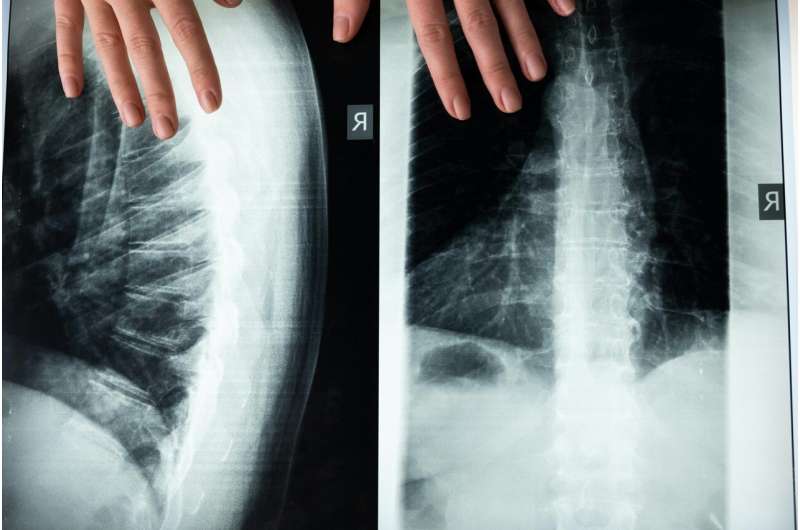This article has been reviewed according to Science X's editorial process and policies. Editors have highlighted the following attributes while ensuring the content's credibility:
fact-checked
trusted source
proofread
AI software yields six-fold increase in spine fracture identification, early findings show

Early findings from the AI-enabled Detection of OsteoPorosis for Treatment (ADOPT) study, which uses a Nanox.AI artificial intelligence solution, HealthVCF, to review routine CT scans, have identified up to six times more patients with vertebral compression fracture than the national average at National Health Services (NHS) hospitals in the U.K.
Results from the NHS Falls and Fragility Fracture Audit Program (FFFAP) show that across ADOPT sites, such as the University Hospital Southampton NHS Foundation Trust, where the HealthVCF bone solution has been deployed, there has been a substantial increase in the rate of patient identification based on spine fractures, surpassing the national average with up to a six-fold increase in the number of patients identified and included for follow-up in the Fracture Liaison Service (FLS) database.
To date, as part of the study the Nanox.AI algorithm has identified more than 2,400 patients with vertebral compression fractures (VCF) from routine CT scans that were not known to the NHS's hospitals, and have since been flagged for follow-up assessments. The study will continue through February 2025.
"My colleagues and I are encouraged by these findings, which show the potential of an AI-directed pathway for identifying vertebral compression fractures in patients who can then be checked for osteoporosis and start treatments that significantly reduce their fracture risk with benefits to the patient, their family, health care system and wider society," said Professor Kassim Javaid, who is leading the research at the Nuffield Department of Orthopedics, Rheumatology and Musculoskeletal Sciences (NDORMS), University of Oxford.
"Leveraging AI-powered population health solutions presents an effective and efficient avenue for early identification of patients at very high risk of fractures, facilitating timely intervention and care. Proactively identifying and intervening in potential health risks not only preserves well-being but also contributes to significant cost savings and return on investment for the health care system."
Osteoporosis is a common progressive bone disease among adults over 50 years of age that causes the bones to weaken, leading to fractures after falls. Unfortunately, certain kinds of fractures, such as VCFs of the spine, are commonly ignored, despite being a strong risk factor for osteoporosis, leaving patients untreated, worsening bone health and even higher fracture risk.
According to the World Congress of Osteoporosis, an estimated 66% of vertebral compression fractures go undetected or unreported in osteoporosis cases. As modern treatments for osteoporosis lead to rapid improvements in bone strength, they reduce fracture risk and thereby contribute to improved independence in patients with lower health care needs.
As such, there have been efforts to introduce FLS into public health systems. An FLS is a proven and internationally recommended health care model of a small team of health care professionals who follow a patient pathway to deliver systematic identification, assessment, treatment recommendations and monitoring to adults with a recent osteoporotic fracture.
A recent systematic review demonstrated that FLS programs yield a positive return on investment in 86.9% of cases with a mean ROI of over ten-fold findings underscore the importance of identifying early signs of fracture and implementing preventive care measures, as well as the economic impact of such initiatives.
"Early findings from the ADOPT study not only demonstrate the potential to improve outcomes for individuals with VCFs, but also show potential cost-savings for major health systems that come from early detection and intervention of a life-altering condition like osteoporosis," said Orit Wimpfheimer, Chief Medical Officer at Nanox. "We look forward to upcoming data analysis from additional sites participating in the ADOPT study in the coming year."



















